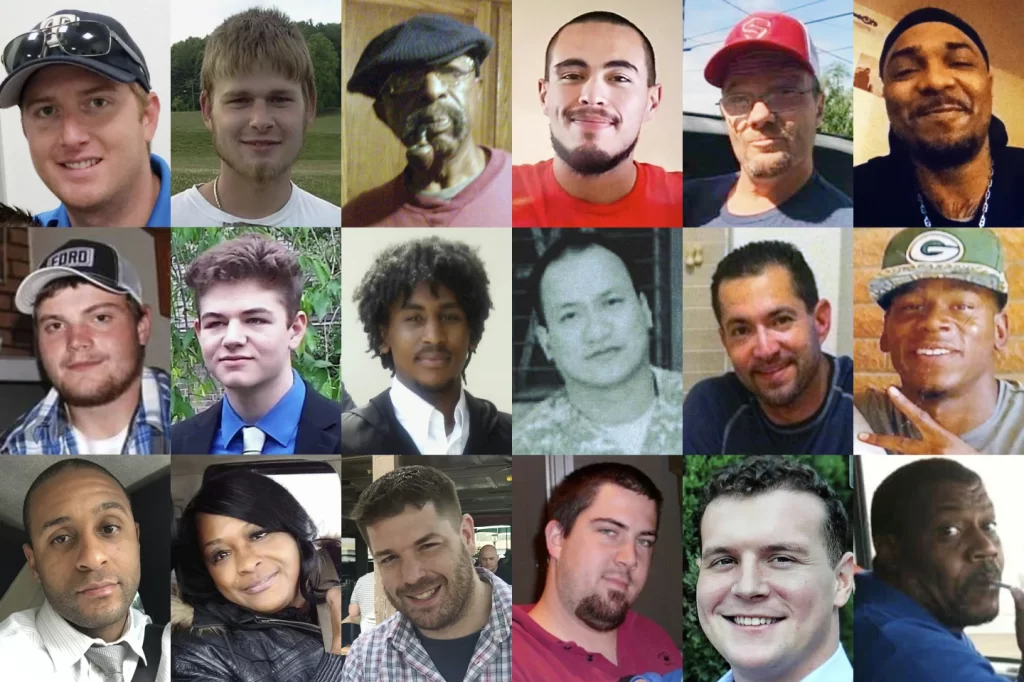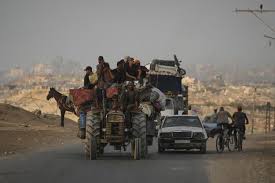
Carl Grant, a Vietnam veteran with dementia, wandered out of a hospital room to charge a cellphone he imagined he had. When he wouldn’t sit still, the police officer escorting Grant body-slammed him, ricocheting the patient’s head off the floor.
Taylor Ware, a former Marine and aspiring college student, walked the grassy grounds of an interstate rest stop trying to shake the voices in his head. After Ware ran from an officer, he was attacked by a police dog, jolted by a stun gun, pinned on the ground and injected with a sedative.
And Donald Ivy Jr., a former three-sport athlete, left an ATM alone one night when officers sized him up as suspicious and tried to detain him. Ivy took off, and police tackled and shocked him with a stun gun, belted him with batons and held him facedown.
Each man was unarmed. Each was not a threat to public safety. And despite that, each died after police used a kind of force that is not supposed to be deadly — and can be much easier to hide than the blast of an officer’s gun.
Every day, police rely on common tactics that, unlike guns, are meant to stop people without killing them, such as physical holds, Tasers and body blows. But when misused, these tactics can still end in death — as happened with George Floyd in 2020, sparking a national reckoning over policing. And while that encounter was caught on video, capturing Floyd’s last words of “I can’t breathe,” many others throughout the United States have escaped notice.
Over a decade, more than 1,000 people died after police subdued them through means not intended to be lethal, an investigation led by The Associated Press found. In hundreds of cases, officers weren’t taught or didn’t follow best safety practices for physical force and weapons, creating a recipe for death.
These sorts of deadly encounters happened just about everywhere, according to an analysis of a database AP created. Big cities, suburbs and rural America. Red states and blue states. Restaurants, assisted-living centers and, most commonly, in or near the homes of those who died. The deceased came from all walks of life — a poet, a nurse, a saxophone player in a mariachi band, a truck driver, a sales director, a rodeo clown and even a few off-duty law enforcement officers.
The toll, however, disproportionately fell on Black Americans like Grant and Ivy. Black people made up a third of those who died despite representing only 12% of the U.S. population. Others feeling the brunt were impaired by a medical, mental health or drug emergency, a group particularly susceptible to force even when lightly applied.
“We were robbed,” said Carl Grant’s sister, Kathy Jenkins, whose anger has not subsided four years later. “It’s like somebody went in your house and just took something, and you were violated.”
AP’s three-year investigation was done in collaboration with the Howard Center for Investigative Journalism programs at the University of Maryland and Arizona State University, and FRONTLINE (PBS). The AP and its partners focused on local police, sheriff’s deputies and other officers patrolling the streets or responding to dispatch calls. Reporters filed nearly 7,000 requests for government documents and body-camera footage, receiving more than 700 autopsy reports or death certificates, and uncovering video in at least four dozen cases that has never been published or widely distributed.
Medical officials cited law enforcement as causing or contributing to about half of the deaths. In many others, significant police force went unmentioned and drugs or preexisting health conditions were blamed instead.
Video in a few dozen cases showed some officers mocked people as they died, laughing or making comments such as “sweaty little hog,” “screaming like a little girl” and “lazy f—.” In other cases, officers expressed clear concern for the people they were subduing.
The federal government has struggled for years to count deaths following what police call “less-lethal force,” and the little information it collects is often kept from the public and highly incomplete at best. No more than a third of the cases the AP identified are listed in federal mortality data as involving law enforcement at all.
When force came, it could be sudden and extreme, the AP investigation found. Other times, the force was minimal, and yet the people nevertheless died, sometimes from a drug overdose or a combination of factors.
In about 30% of the cases, police were intervening to stop people who were injuring others or who posed a threat of danger. But roughly 25% of those who died were not harming anyone or, at most, were committing low-level infractions or causing minor disturbances, AP’s review of cases shows. The rest involved other nonviolent situations with people who, police said, were trying to resist arrest or flee.
A Texas man loitering outside a convenience store who resisted going to jail was shocked up to 11 times with a Taser and restrained facedown for nearly 22 minutes — more than twice as long as George Floyd, previously unreported video shows. After a California man turned silent during questioning, he was grabbed, dogpiled by seven officers, shocked five times with a Taser, wrapped in a restraint contraption and injected with a sedative by a medic despite complaining “I can’t breathe.” And a Michigan teen was speeding an all-terrain vehicle down a city street when a state trooper sent volts of excruciating electricity from a Taser through him, and he crashed.
In hundreds of cases, officers repeated errors that experts and trainers have spent years trying to eliminate — perhaps none more prevalent than how they held someone facedown in what is known as prone restraint.
Many policing experts agree that someone can stop breathing if pinned on their chest for too long or with too much weight, and the Department of Justice has issued warnings to that effect since 1995. But with no standard national rules, what police are taught is often left to the states and individual departments. In dozens of cases, officers disregarded people who told them they were struggling for air or even about to die, often uttering the words, “I can’t breathe.”
What followed deadly encounters revealed how the broader justice system frequently works to shield police from scrutiny, often leaving families to grieve without knowing what really happened.
Officers were usually cleared by their departments in internal investigations. Some had a history of violence and a few were involved in multiple restraint deaths. Local and state authorities that investigate deaths also withheld information and in some cases omitted potentially damaging details from reports.
One of the last hopes for accountability from inside the system — what are known as death opinions — also often exonerated officers. The medical examiners and coroners who decide on these did not link hundreds of the deaths to force, but instead to accidents, drug use or preexisting health problems, sometimes relying on debunked science or incomplete studies from sources tied to law enforcement.
Even when these deaths receive the homicide label that fatal police shootings often get, prosecutors rarely pursue officers. Charging police is politically sensitive and can be legally fraught, and the AP investigation identified just 28 deaths that led to such charges. Finding accountability through civil courts was also tough for families, but at least 168 cases ended in settlements or jury verdicts totaling about $374 million.
The known fatalities still averaged just two a week — a tiny fraction of the total contacts police have with the population. Police leaders, officers and experts say law enforcement shouldn’t bear all the blame. As the social safety net frays, people under mental distress or who use stimulant drugs like cocaine or methamphetamine are increasingly on the streets. Officers sent to handle these emergencies are often poorly trained by their departments.
If incidents turn chaotic and officers make split-second decisions to use force, “people do die,” said Peter Moskos, a professor at John Jay College of Criminal Justice and former Baltimore police officer.
“The only way to get down to zero is to get rid of policing,” Moskos said, “and that’s not going to save lives either.”
But because the United States has no clear idea how many people die like this and why, holding police accountable and making meaningful reforms will remain difficult, said Dr. Roger Mitchell Jr., a leader in the push to improve tracking and one of the nation’s few Black chief medical examiners when he held the office in Washington, D.C., from 2014 to 2021.
“Any time anyone dies before their day in court, or dies in an environment where the federal government or the local government’s job is to take care of you,” he said, “it needs transparency. It cannot be in the dark of night.”





